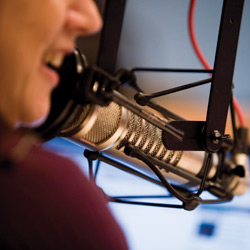
You likely find the vast spectrum of media available today to be mind-boggling. If that’s the case, imagine the confusion when a dramatic increase in the number of choices is layered on over the next few years.
Already, a plethora of online and on-demand video content is freely available, along with traditional linear video content. Audio services offer customized listening experiences. Mobile streaming platforms and social media usage continue to explode. Over-the-top TV, the delivery of video via the Internet, will provide video and services any time, anywhere on essentially any type of device, from the TV in your family room to your smartphone. Dynamic ad targeting and behavioral targeting is being continually refined, and print publications are delivering content to tablets like the iPad.
Do today’s businesses need to integrate these new platforms and concepts into their marketing efforts? Not always, but in many cases, yes. However, using these new platforms as replacements for traditional media is often a disaster. Further, it’s often the traditional media companies which have the most robust new media opportunities.
While new media is often becoming a necessary addition to marketing strategies, ongoing research indicates that traditional media is as critical as ever.
For instance, while it may seem like satellite or Internet radio is all the rage, consider that roughly three percent of Americans use digital services like Pandora or Sirius XM. On the other hand, 93 percent listen to AM/FM radio (96 percent in key age groups) and AM/FM radio has actually added 1.9 million weekly listeners in the past year. While television faces fragmentation, the fact is that even top cable channels which have been around for years—never mind Internet-based options—fail to attract a fraction of the audience of prime programming on local TV stations.
Almost any broad marketing or advertising effort must use traditional media. The key for most marketers is integration of traditional media with online and mobile platforms to target, engage and deliver consumers.
Traditional media is, however, being forced to continually evolve and adapt to the realities of a multi-platform world. It’s a world where your local newspaper also wants to be your video news source, your local broadcasters also want to be your favorite local Internet portals, and your phone company also wants to be your cable provider.
Ironically, media companies may eventually all grow to be similar in their platform offerings. At that point, content will be one key point of differentiation of one multi-platform provider from the other.
The platforms on which content is consumed are expected to evolve rapidly. The best example of this may be that nearly 300 million Americans own cell phones, and a significant and fast-growing portion of those phones let users listen to radio, watch television and read newspaper content, as well as online browsing and numerous other applications and new media functions. Penetration on mobile devices will become increasingly critical to all media.
Despite the ongoing potential of mobile and its anticipated future impact, that growth may be stunted as most consumers have yet to pay the true cost of using their mobile devices. Carriers like Verizon and AT&T have seen exponential growth in data usage and are now focused on metering, which in turn will likely impact how consumers feel about using their smartphones for streaming audio and video. The average smartphone uses 15 times the data of the standard cell phone, and the average iPad uses 30 times the data of a smartphone. Still, the mobile device will be a key platform for all media in the future.
The future is bright for new media platforms, yet challenges abound for new media. Seeking expertise on the integration and alignment of new media opportunities with traditional media will be an important step for strategic marketing in the future. iBi
Mike Wild is senior vice president of JMP Radio Group and a 30-year veteran of the broadcast industry.

